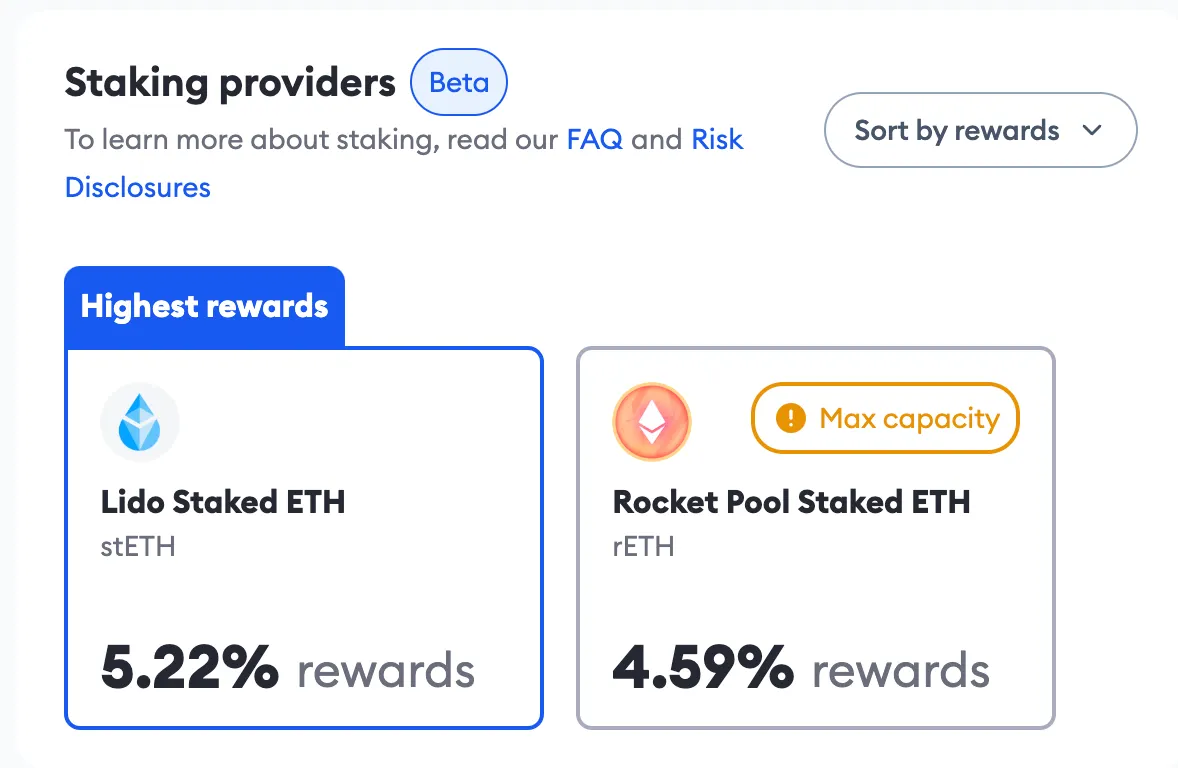The popular crypto wallet MetaMask has launched its staking functionality, meaning that users can now lock up their Ethereum through the new feature via Lido or Rocket Pool to earn financial rewards.
What that means is anyone with a MetaMask wallet can now easily start earning yield on any amount of ETH they’d like right from their wallet, and without having to navigate what can often be complicated user interfaces on staking applications. But should they?
Staking, after all, isn’t without risk—not to mention the fact that unstaking (i.e. getting your ETH back from a staking contract) isn’t an option right now. Ethereum developers say, however, that this feature will be coming soon.
WEN STAKING?
We are extremely happy to announce that you can now stake ETH with Lido or Rocket Pool through the Portfolio Dapp🎉
🔗https://t.co/HVLvcSDbw6 pic.twitter.com/9VkiU5jlsw
— MetaMask 🦊💙 (@MetaMask) January 13, 2023
Staking Providers
For users who don’t mind the risks, staking can be a lucrative activity. While the rewards rates vary, MetaMask’s site claims users can earn a yield of about 5.22% per year on ETH deposits with Lido, and 4.59% with Rocket Pool.
According to Lido’s website, over $6.9 billion of ETH is currently staked through its service, earning users roughly 4.9% annually. Lido is a so-called liquid staking provider, meaning users who stake ETH through Lido receive an equivalent amount of Staked Ethereum (stETH) in return for their staked tokens. This enables stakers to remain “liquid” while locking up their ETH, allowing them to use their stETH on other DeFi services.
Staked Ethereum currently trades at a slight discount to ETH. While ETH is priced at around $1,418, stETH currently trades for $1,407, per CoinGecko data.
Lido is currently the most popular staking provider, with 29% of all staked ETH, according to Dune Analytics data.
Rocket Pool is another liquid staking service, which provides users with rETH in return for their staked tokens. But Rocket Pool on MetaMask appears to have already reached “max capacity,” meaning users may only have the option to stake ETH through Lido on MetaMask for now.

How many have already staked through MetaMask so far? While MetaMask’s Senior Product Manager Abad Mian did not offer precise numbers, he told Decrypt that the team is pleased with the rollout thus far.
“We started rolling out yesterday at 10% with full roll-out today. We have seen an exciting engagement since the news went live four hours ago,” Mian said.
But there are other options for ETH staking beyond the two providers MetaMask now offers through its platform. Coinbase, Binance US, Kraken, and Nexo also offer Ethereum staking, each with varying rewards rates. Of those centralized providers, only Coinbase and Nexo currently offer a liquid staking option, returning Coinbase Wrapped Staked ETH (cbETH) tokens or Nexo Staked Ethereum (NETH) in exchange for ETH, respectively.
Solo staking is also an option—but users will need a minimum of 32 ETH (roughly $45,800) to do so.
Staking Benefits
Because Ethereum is a proof-of-stake blockchain, more users staking ETH and running validators around the globe will, in theory, make the network more secure and decentralized over time. That’s a good thing for the network, which has been criticized for being more centralized when compared to Bitcoin.
Passive income through staking rewards might also seem like a no-brainer to some who are long-term holders and don’t plan to immediately sell or trade their bags of ETH in the short term.
Staking Risks
But locking up crypto with a third party has its risks. There’s a common phrase in crypto: “Not your keys, not your coins.” And it has unfortunately rung true as the market deals with the devastating effects of Terra’s crash and FTX’s meltdown. Even now, as Gemini shutters its “Earn” program following the collapses of crypto lenders BlockFi and Celsius, should holders ever trust their crypto with a third party at all? What are the risks, and what do Ethereum developers think?
MetaMask parent firm ConsenSys explained in a post last month what it believes to be the primary risks that come with staking ETH. Specifically, it points to potential risks surrounding compromised third-party software, buggy smart contracts, and substantial token price fluctuations.
It also raises the possible risks associated with undesirable governance decisions made through any related DAOs, issues with code transfers, “legal uncertainty,” and the possibility of compromised private keys. While that might seem like a broad range of potential risks, each one is possible if the user compromises their own data—or a powerful third-party makes decisions that change the rules of the game.
Staking Withdrawals
Before considering staking Ethereum, it’s essential to know that unstaking is not currently available. This means that right now, your Ethereum can go in—but it can’t yet come out. This might come as a shock to some, as it means that staking is currently a one-way experience, but Ethereum developers have plans to change that very soon.
The Shanghai update slated for early this year will enable staked ETH withdrawals.
“After the Shanghai update, stakers will then be able to withdraw their rewards and/or principle deposit from their validator balance if they choose,” the Ethereum Foundation’s website reads.
Ethereum developer Marius van der Wijden told Decrypt that withdrawals could come as soon as March.
“We have launched three withdrawal devnets and will do some withdrawal shadow forks soon (where we enable the feature on a shadow copy of the normal Ethereum chain),” he told Decrypt in a message. “Withdrawals are expected to go live in March.”
As to whether Ethereum holders should stake their ETH or not, “people should listen to their gut whether they want to stake now or in a couple of months,” van der Wijden said.
“The code for withdrawals is mostly done, but it still needs to be thoroughly tested before being rolled out,” he said.

